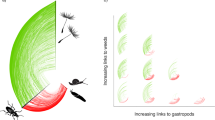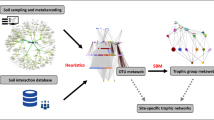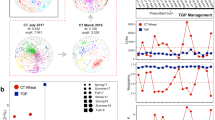Abstract
Sustainable management of ecosystems and growth in agricultural productivity is at the heart of the United Nations’ Sustainable Development Goals for 2030. New management regimes could revolutionize agricultural production, but require an evaluation of the risks and opportunities. Replacing existing conventional weed management with genetically modified, herbicide-tolerant (GMHT) crops, for example, might reduce herbicide applications and increase crop yields, but remains controversial owing to concerns about potential impacts on biodiversity. Until now, such new regimes have been assessed at the species or assemblage level, whereas higher-level ecological network effects remain largely unconsidered. Here, we conduct a large-scale network analysis of invertebrate communities across 502 UK farm sites to GMHT management in different crop types. We find that network-level properties were overwhelmingly shaped by crop type, whereas network structure and robustness were apparently unaltered by GMHT management. This suggests that taxon-specific effects reported previously did not escalate into higher-level systemic structural change in the wider agricultural ecosystem. Our study highlights current limitations of autecological assessments of effect in agriculture in which species interactions and potential compensatory effects are overlooked. We advocate adopting the more holistic system-level evaluations that we explore here, which complement existing assessments for meeting our future agricultural needs.
This is a preview of subscription content, access via your institution
Access options
Access Nature and 54 other Nature Portfolio journals
Get Nature+, our best-value online-access subscription
$29.99 / 30 days
cancel any time
Subscribe to this journal
Receive 12 digital issues and online access to articles
$119.00 per year
only $9.92 per issue
Buy this article
- Purchase on Springer Link
- Instant access to full article PDF
Prices may be subject to local taxes which are calculated during checkout



Similar content being viewed by others
Data availability
The raw FSE data are free from intellectual property rights. The data can be requested by enquiry to the Environmental Information Data Centre of the Centre for Ecology and Hydrology (http://eidc.ceh.ac.uk/contact). Archived information about the FSEs are available from the National Archives of The Government of the United Kingdom (http://webarchive.nationalarchives.gov.uk/20080306073937/http://www.defra.gov.uk/environment/gm/fse/).
References
Tilman, D. et al. Global food demand and the sustainable intensification of agriculture. Proc. Natl Acad. Sci. USA 108, 20260–20264 (2011).
Flohre, A. et al. Agricultural intensification and biodiversity partitioning in European landscapes comparing plants, carabids, and birds. Ecol. Appl. 21, 1772–1781 (2011).
Rockström, J. et al. A safe operating space for humanity. Nature 461, 472–475 (2009).
Geiger, F. et al. Persistent negative effects of pesticides on biodiversity and biological control potential on European farmland. Basic Appl. Ecol. 11, 97–105 (2010).
Butler, S. J. et al. Farmland biodiversity and the footprint of agriculture. Science 315, 381–384 (2007).
Foley, J. A. et al. Solutions for a cultivated planet. Nature 478, 337–342 (2011).
Firbank, L. G. et al. Assessing the impacts of agricultural intensification on biodiversity: a British perspective. Phil. Trans. R. Soc. B 363, 777–787 (2008).
Brooks, D. R. et al. The implications of genetically modified herbicide-tolerant crops for uk farmland biodiversity : a summary of the results of the farm scale evaluations project. In Proc. Cultiv. Genet. Modif. Crop. Eval. Ecol. Eff. 29–52 (2007).
Phalan, B. et al. Minimising the harm to biodiversity of producing more food globally. Food Policy 36, S62–S71 (2011).
Bohan, D. A. et al. Networking our way to better ecosystem service provision. Trends Ecol. Evol. 31, 105–115 (2016).
Bohan, D. A. et al. Next-generation global biomonitoring: large-scale, automated reconstruction of ecological networks. Trends Ecol. Evol. 32, 477–487 (2017).
Thompson, R. M. et al. Food webs: reconciling the structure and function of biodiversity. Trends Ecol. Evol. 27, 689–697 (2012).
Hautier, Y. et al. Eutrophication weakens stabilizing effects of diversity in natural grasslands. Nature 508, 521–525 (2014).
Bohan, D. A. et al. Automated discovery of food webs from ecological data using logic-based machine learning. PLoS ONE 6, e29028 (2011).
Firbank, L. G. et al. An introduction to the farm-scale evaluations of genetically modified herbicide-tolerant crops. J. Appl. Ecol. 40, 2–16 (2003).
Chamberlain, D. E. et al. Changes in the abundance of farmland birds in relation to the timing of agricultural intensification in England and Wales. J. Appl. Ecol. 37, 771–788 (2000).
Hawes, C. et al. Functional approaches for assessing plant and invertebrate abundance patterns in arable systems. Basic Appl. Ecol. 10, 34–42 (2009).
Haughton, A. J. et al. Invertebrate responses to the management of genetically modified herbicide-tolerant and conventional spring crops. II. Within-field epigeal and aerial arthropods. Phil. Trans. R. Soc. Lond. B 358, 1863–1877 (2003).
Jordán, F. Keystone species and food webs. Phil. Trans. R. Soc. Lond. B 364, 1733–1741 (2009).
Lu, X. et al. Drought rewires the cores of food webs. Nat. Clim. Change 6, 875–878 (2016).
McCann, K. et al. Weak trophic interactions and the balance of nature. Nature 395, 794–798 (1998).
Jacquet, C. et al. No complexity–stability relationship in empirical ecosystems. Nat. Commun. 7, 12573 (2016).
Ma, A. & Mondragón, R. J. Rich-cores in networks. PLoS ONE 10, e0119678 (2015).
Gaston, K. J. Valuing common species. Science 327, 154–155 (2010).
Liu, Y.-Y. et al. Controllability of complex networks. Nature 473, 167–173 (2011).
Brede, M. Coordinated and uncoordinated optimization of networks. Phys. Rev. E 81, 66104 (2010).
Dunne, J. A. et al. Network structure and biodiversity loss in food webs: robustness increases with connectance. Ecol. Lett. 5, 558–567 (2002).
Brookes, G. & Barfoot, P. Environmental impacts of genetically modified (GM) crop use 1996–2015: impacts on pesticide use and carbon emissions. GM Crops Food 8, 117–147 (2017).
Raybould, A. & Poppy, G. M. Commercializing genetically modified crops under EU regulations. GM Crops Food 3, 9–20 (2012).
The Millennium Development Goals Report 2012 (United Nations Development Programme, 2012).
Bairey, E., Kelsic, E. D. & Kishony, R. High-order species interactions shape ecosystem diversity. Nat Commun. 7, 12285 (2016).
Levine, J. M., Bascompte, J., Adler, P. B. & Allesina, S. Beyond pairwise mechanisms of species coexistence in complex communities. Nature 546, 56–64 (2017).
Kaiser-Bunbury, C. N. & Bluthgen, N. Integrating network ecology with applied conservation: a synthesis and guide to implementation. AoB Plants 7, plv076 (2015).
Dormann, C. F., Fründ, J. & Schaefer, H. M. Identifying causes of patterns in ecological networks: opportunities and limitations. Annu. Rev. Ecol. Evol. Syst. 48, 559–584 (2017).
Rothery, P. et al. Design of the farm-scale evaluations of genetically modified herbicide-tolerant crops. Environmetrics 14, 711–717 (2003).
Tamaddoni-Nezhad, A. et al. Construction and validation of food webs using logic-based machine learning and text mining. Adv. Ecol. Res. 49, 225–289 (2013).
Tamaddoni-Nezhad, A et al. Machine learning a probabilistic network of ecological interactions. in Proc. 21st International Conference on Inductive Logic Programming (ILP’11) (Springer, 2012).
Davey, J. S. et al. Intraguild predation in winter wheat: prey choice by a common epigeal carabid consuming spiders. J. Appl. Ecol. 50, 271–279 (2013).
Bray, J. R. & Curtis, J. T. An ordination of the upland forest communities of southern Wisconsin. Ecol. Monogr. 27, 325–349 (1957).
Borgatti, S. P. & Everett, M. G. Models of core/periphery structures. Soc. Networks 21, 375–395 (1999).
Csermely, P. et al. Structure and dynamics of core/periphery networks. J. Complex Networks 1, 93–123 (2013).
Csete, M. & Doyle, J. Bow ties, metabolism and disease. Trends Biotechnol. 22, 446–450 (2004).
Zhou, S. & Mondragon, R. J. The rich-club phenomenon in the internet topology. IEEE Commun. Lett. 8, 180–182 (2004).
Woodward, G. et al. Climate Change impacts in multispecies systems: drought alters food web size structure in a field experiment. Phil. Trans. R. Soc. Lond. B 367, 2990–2997 (2012).
Memmott, J. et al. Tolerance of pollination networks to species extinctions. Proc. R. Soc. Lond. B 271, 2605–2611 (2004).
Acknowledgements
We thank J. Bigham, P. Curtis, P. Kratina, B. Parker and R. Bailey for their comments and discussion. X.L. and C.G. were supported by Queen Mary University of London. X.L. was additionally supported by the Chinese Scholarship Council and C.G. was additionally supported by the Freshwater Biological Association. D.A.B. acknowledges the support of the FACCE SURPLUS PREAR and ANR (ANR-17-CE32-011) NGB projects.
Author information
Authors and Affiliations
Contributions
A.M. and D.A.B. designed the research. D.A.B. and A.T.-N. contributed materials and datasets. X.L. implemented the analysis. X.L. and C.G. analysed the data. A.M., X.L., C.G., A.R., G.W. and D.A.B. discussed the results. A.M. and D.A.B. led the paper writing with input from all authors.
Corresponding author
Ethics declarations
Competing interests
A.R. is employed by Syngenta, which develops and markets genetically modified seed products.
Additional information
Publisher’s note: Springer Nature remains neutral with regard to jurisdictional claims in published maps and institutional affiliations.
Supplementary information
Supplementary Information
Supplementary Methods 1–2, Supplementary Figures 1–6 and Supplementary Tables 1–3
Rights and permissions
About this article
Cite this article
Ma, A., Lu, X., Gray, C. et al. Ecological networks reveal resilience of agro-ecosystems to changes in farming management. Nat Ecol Evol 3, 260–264 (2019). https://doi.org/10.1038/s41559-018-0757-2
Received:
Accepted:
Published:
Issue Date:
DOI: https://doi.org/10.1038/s41559-018-0757-2



